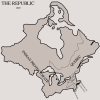St. Peters Field: The Making of the Peoples Republic of Britain
Some Background to the Events before the Revolution
In 1819, Great Britain was at a crossroads. but large scale agricultural problems, coupled with little suffrage in the North of England, and the passing of the Corn Laws in the same year as Napoleons defeat, had exacerbated rising economic problems, and social disgruntlement.
On August 16th, things came to a head. At St. Peters Field, in Manchester a large crowd had gathered to hear Henry Hunt, a famous radical orator, speak on behalf of the Manchester Patriotic Union. As the unusually large crowd, between 60-80,000, larger than ever before had been seen for a political rally, local magistrates decided that they had to quell a possible danger. Military officers and soldiers were called in to serve warrants, and a cavalry unit of 60 men of the Manchester and Salford Yeomanry , lead by Captain Hugh Hornby Birley, was tasked by Chief Constable Johnathon Andrews to serve it. While some accounts have stated that a good lot of the men were drunk. However, what happened next would start the flame of revolution. On the orders of the Captain, the group were to process through the crowd, and up to the stage to detain and arrest Hunt. However, a cross-exchange of words sent the cavalrymen charging into the crowd. As they slashed their way towards the stage, the crowd began to panic.
Hunt managed to escape, along with many of the Manchester Patriotic Union organizers. However, the ensuing debacle cost the lives of thirty people, and over 600 were wounded either by the soldiers, or the ensuing panicked crush of people attempting to escape. Four of the soldiers were dragged from their horses, and beaten by some members of the crowd however. This began the spark of revolution.
The Revolution From Its Beginning To The Current Time:
By August 20th, Manchester itself was nearing total rebellion, and across the country, an outpouring of public sympathy (and in some cases criticism) of those injured or killed had risen. However, several mistakes made in the governance of the ensuing conflagration of spirits would only add fuel to the fire.
The Parliament was locked in whether to start reform or punish those responsible. King George III was currently in no state of good health, and his son, the Prince of Wales, was often either drunk or too busy with his personal pleasures to pay much attention. When first informed of it, he did write a detailed letter to the Manchester Chief Constable, urging him to keep the peace, but soon gave little thought of it. However, it would be deadly serious later. As Manchester soon began to feed into the anger and the percieved inaction of Parliament, and the blatant hostility against the Prince of Wales, Hunt, the escaped orator, began to fuel the fire. As it rolled into late October, the city was a powder keg. It blew up on the 24th.
A respected merchant was beaten and jailed by a group of constables, who felt he was "communicating messages of the sort to inflame the populace." As crowds gathered outside the jail to protest his arrest, a few soldiers of the Army were brought in to keep the crowds back. An errant brick which dashed the units officer to the ground, caused a soldier to fire his musket into the air. However, this caused the crowd to surge forward, and causing the soldiers to bayonet several who attempted to mob them. The soldiers were overwhelmed, and forced out of the way. The Chief Constable was dragged out, and tarred and feathered by several MPU thugs.
In the chaos that followed, Hunt managed to convince the populace that no one would be given the freedoms they needed under the King and his son. On November 14th, a comittee formed into the Manchester Peoples Delegation, delclared the community and its surrounding environs as a new government.
As military and civilian law enforcement attempted to arrest these men in the name of the King, several fled the ranks and joined the growing populist front. A near total breakdown of law and order occurred before the provisional Manchester Peoples Delegation Government, was able to restore order by November 24th. Consolidation of the people, their provisions, and so on, were the first order of business.
In 1820, the nation was under siege. The British government had moved the army to stop it, but several soldiers, seeing the problems of the people, either deserted, or began to grumble in secret. In fact, given the lack of morale and obvious influence of the revolutionary government in Manchester on the men, several commanders pulled back, ceeding land rather than have their men desert en masse.
It would be between July of 1820 and January of 1821 that the biggest gain would be made. Circulators of pamphlets and other material, appealing to the Welsh poor and destitute, along with others who they felt would be affected by the British rule, managed to convince them to join the Revolutionary nation being formed. Almost the entirety of Wales joined in the fervor. On March 1st, 1821 the government of the MPDC resigned, and reformed as the government of the newly formed Peoples Republic of Britain, based on a mixture of the ideals of their own, and of the United States. Currently, the British government is still attempting to bring the PRB back into the fold.
The lines on the map below mark the progress of the PRB over the last few years, with 1821 marking the current zone of their expansion.



